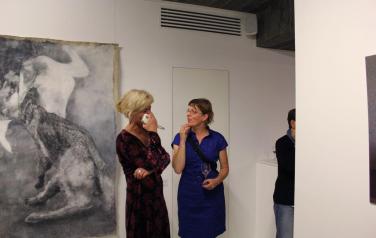Artists:
- Kawarga (RU) – www.kawarga.ru
- Annouk Thys (BE) – www.annoukthys.net
- Vika Begalska (RU) – www.vikabegalska.ru
- Maaike Leyn (BE) – www.nucleo.be/artist/index/nl/86
- Debby Huysmans (BE) – www.debbyhuysmans.be/
Curator: Maaike Leyn
In Western Europe we try to encapsulate reality. Everything is needed to be placed into a kind of “capsule”. We draw a line around each car; we have a stand for each bike. Each square meter has its own function: we fix places where people should live, where industrial area, agricultural area and forests should be. At the same time there are no places without destination. We believe that “encapsulating” helps to control reality. We put signatures, labels, designations, count ratings. Unfortunately instead of controlling, we destroy complexity. Reality is much more interesting and beauty is chaotic.
In our Western society everything is extremely ordered and regulated. This is partly so because of the high population density and small area. The area in Russia is large and as a consequence it gives a sense of freedom. In Russia parks are what Western people call forests, forests what Western people call woods, and Russian woods what Western people call infinity. Russian people don’t put their cars between lines, they put their cars where is place to park. Travelling to Russia is escaping out of the cage and a confrontation with the uncontrolled. Russia is full of physical free spaces and those spaces translate themselves also into mental space. Of course there are severe rules, but in a sense they are rough. In Russia, no one will try to make a separate rule for “exceptions” for one square meter, which is different from the others and therefore requires a separate control. Russia is too big to incorporate every detail and because of that it’s impossible to encapsulate everything. As a consequence Russia is maybe more able to accept the fact that in life it’s impossible to control everything.
A way to escape from this Western encapsulating reality surrounding us is art. The artists involved in the exhibition “Free places” accept and incorporate the natural chaos in their works. Creating art is both a process of provocation and adoption. A well known Belgian artist Elly Stik presented Marcel Duchamps, as the bride and groom at the same time. An artist is both man and woman: he is acting but also accepting.
The most interesting and the most important is what created beyond our own control and gives rise to a new life of the artwork. It is extremely important to understand this and accept the new as a gift. This process can be compared to childbirth. You can not predict who this child will be and you have to accept it the way it is, but meanwhile its senseless to give it complete freedom, you have to try to make a good person out of this small person. In art you also have to try to find this balance between what happened and how you react on it. Unexpected things happen, we accept them, and try to find an answer. There are no rules, because each situation is different from the previous one and requires new solutions.
If you take a bulldozer to ruin an old building, and construct a new one, completely under control, you get a superficial, shallowness new building. But it’ll be a construction without a soul. Building a new, not taking the past, we just destroy the story and create barriers. If we renovate the building we take it back and give freedom to the past. We are creating a path to the past, but also to the future, the unknown, to an open space without limits. And that’s what art about, it’s about taking part into eternity and complexity. It’s a game to become free.






















